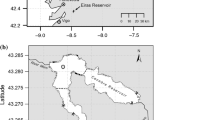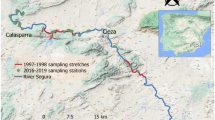Abstract
The diet of the Iberian otter (Lutra lutra) was determined by analysing 547 spraints collected at 28 sites within a wide area invaded by centrarchid fishes (pumpkinseed sunfish, Lepomis gibbosus and largemouth bass, Micropterus salmoides): the middle Guadiana basin (South-west Iberian Peninsula). Fish was the otters’ main prey, representing more than 60% of total individuals and more than 80% of total biomass. Otters preyed on most of the fish species captured in the field; however, the consumption of centrarchids was low compared to their abundance in the streams, and Jacobs’ index of preference showed a clear rejection of both species by the otter. Consumption of native fish genera (Squalius, Barbus and Chondrostoma) by otters increased in relation to their increase in the environment. In contrast, increasing numbers of L. gibbosus in the field was not reflected in otter consumption. The general decline of native freshwater fishes in Iberian rivers, the preferred prey of otters, together with the spread of exotic fish species (centrarchids and others) could put otter populations at risk.



Similar content being viewed by others
References
Adrián MI, Delibes M (1987) Food habits of the otter (Lutra lutra) in two habitats of the Doñana National Park, SW Spain. J Zool Lond 212:399–406
Almaça C (1965) Contribution à la connaisance des poissons d’eaux interieures du Portugal. Arquiv Mus. Bocage 1:9–39
Almaça C (1995) Fish species and varieties introduced into Portuguese inland waters. Lisboa: Publ. Avuls Mus. Bocage
Aparicio E, Vargas MJ, Olmo JM, de Sostoa A (2000) Decline of native freshwater fishes in a Mediterranean watershed on the Iberian Peninsula: a quantitative assessment. Environ Biol Fishes 59:11–19
Beja PR (1996) An analysis of otter Lutra lutra predation on introduced American crayfish Procambarus clarkii in Iberian streams. J Appl Ecol 33:1156–1170
Beja PR (1997) Predation by marine-feeding otters (Lutra lutra) in South-west Portugal in relation to fluctuating food resources. J Zool Lond 242:503–518
Bernardo JM, Ilhéu M, Matono P, Costa AM (2003) Interannual variation of fish assemblage structure in a Mediterranean river: implications of stream flow on the dominance of native or exotic species. Riv Res Appl 19:521–532
Blanco-Garrido F (2006) Ecología, distribución y conservación de peces continentales en el cuadrante suroccidental ibérico. Ph D Thesis. Universidad de Huelva
Clavero M, Garcia-Berthou E (2006) Homogenization dynamics and introduction routes of invasive freshwater fish in the Iberian Peninsula. Ecol Appl 16:2313–2324
Clavero M, Blanco-Garrido F, Prenda J (2004) Fish fauna in Iberian Mediterranean river basins: biodiversity, introduced species and damming impacts. Aquat Conserv Mar Freshw Ecosyst 14:575–585
Clavero M, Prenda J, Delibes M (2003) Trophic diversity of the otter (Lutra lutra L) in temperate and Mediterranean freshwater habitats. J Biog 30:761–769
Collares-Pereira MJ, Cowx IG, Ribeiro F, Rodrigues JA, Rogado L (2000) Threats imposed by water resource development schemes on the conservation of endangered fish species in the Guadiana river Basin in Portugal. Fish Manag Ecol 7:167–178
Correia AM (2001) Seasonal and interspecific evaluation of predation by mammals and birds on the introduced red swamp crayfish Procambarus clarkii (Crustacea, Cambaridae) in a freshwater marsh (Portugal). J Zool Lond 255:533–541
Delibes M, Adrián MI (1987) Effects of crayfish introduction on otter Lutra lutra food in the Doñana National Park, SW Spain. Biol Conserv 42:153–159
Doadrio I (ed) (2002) Atlas y libro rojo de los peces continentales de España. Dirección General de Conservación de la Naturaleza. 2nd edn
Eklöv P, Hamrin SF (1989) Predatory efficiency and prey selection: interactions between pike Esox lucius, perch Perca fluviatilis and rudd Scardinius erythrophthalmus. Oikos 56:149–156
Erlinge S (1968) Food studies on captive otters (Lutra lutra L.). Oikos 19:259–270
Filipe AF, Cowx IG, Collares-Pereira MJ (2002) Spatial modelling of freshwater fish in semi-arid river systems: a tool for conservation. River Res Appl 18:123–136
Godinho FN, Ferreira MT (2000) Composition of endemic fish assemblages in relation to exotic species and river regulation in a temperate stream. Biol Invasions 2:231–244
Hasburgo-Lorena AS (1983) The status of the Procambarus clarkii population in Spain. Freshw Crayfish 6:131–133
Heggberget TM, Moised KE (1994) Prey selection in coastal Eurasian otters Lutra lutra. Ecography 17:331–338
Holling CS (1959) Some characteristics of simple types of predation and parasitism. Can Entomol 91:385–398
Jacobs J (1974) Quantitative measurement of food selection. A modification of the forage ratio and Ivlevs electivity index. Oecologia 14:413–417
Jacobsen L (2005) Otter (Lutra lutra) predation on stocked brown trout (Salmo trutta) in two Danish lowland rivers. Ecol Fresh Fish 14:59–68
Kruuk H, Goudswaard PC (1990) Effects of changes in fish populations in Lake Victoria on the food of otters (Lutra maculicollis Schinz and Aonyx capensis Lichtenstein). African J Ecol 28:322–329
Lanski J, Molnar T (2003) Diet of otters living in three different habitats in Hungary. Folia Zool 52:378–388
de López F, de la Cruz C (1985) Lepomis gibbous L. (Perciformes, Centrarchidae) nueva especie en la ictiofauna del Guadiana. Doñana Acta Vertebrata 12(1):165–166
López-Nieves P, Casal H (1984) Food habits of the otter in central Sierra Morena (Córdoba, Spain). Acta Theriol 29:383–401
Mason CF and Macdonald SM (1986) Otters: ecology and conservation. Cambridge University Press
Morales JJ, Lizana M, Acera F (2004) Ecología trófica de la nutria paleártica (Lutra lutra) en el río Francia (cuenca del Tajo, Salamanca). Galemys 16:57–77
Pedroso NM, Santos-Reis M (2006) Summer diet of Eurasian otters in large dams of south Portugal. Hystrix 17:117–128
Peris SJ, Briz FJ, Campos F (1995) Shifts in the diet of the grey heron (Ardea cinerea) in the Duero basin, central-west Spain, following the introduction of exotic fish species. Folia Zool 44:97–102
Prenda J, Granado-Lorencio C (1996) The relative influence of riparian habitat structure and fish availability on otter Lutra lutra L. sprainting activity in a small Mediterranean catchment. Biol Conserv 76:9–15
Prenda J, Arenas MP, Freitas D, Santos-Reis M, Collares-Pereira MJ (2002) Bone length of Iberian freshwater fish, as predictor of length and biomass of prey consumed by piscivorous. Limnética 21:15–24
Revilla E, Palomares F (2002) Does local feeding specialization exist in Eurasian badgers? Can J Zool 80:83–93
Revilla E, Palomares F, Delibes M (2000) Defining key habitats for low density populations of Eurasian badgers in Mediterranean environments. Biol Conserv 95:269–277
Roselló E (1986) Atlas osteológico de los teleósteos ibéricos. I. Mandíbula inferior (dentario y articular). Tesis de Licenciatura. UAM, Madrid
Ruiz-Olmo J and Delibes M (1998) La nutria en España ante el horizonte del año 2000. SECEM
Ruiz-Olmo J, López-Martín JM, Palazón S (2001) The influence of fish abundance on the otter (Lutra lutra) populations in Iberian Mediterranean habitats. J Zool Lond 254:325–336
Sheldon WG, Toll WG (1964) Feeding habits of the river otter in a reservoir in central Massachusetts. J Mammal 45:449–455
Taastrøm HM, Jacobsen L (1999) The diet of otters (Lutra lutra L.) in Danish freshwater habitats: comparisons of prey fish populations. J Zool Lond 248:1–13
Webb JB (1980) Otter spraint analysis. Occasional Publication, Mammal Society, London
Acknowledgements
We greatly acknowledge Miguel Clavero, Antonia Rebollo and Jerónimo Valle for field and lab assistance. Professor Peter B. Moyle provided very useful comments and suggestions on the edition of the manuscript. Dr. Drake and two anonymous referees made very valuable suggestions to early versions of the manuscript. This study was financially supported by the SECEM (Sociedad Española para la Conservación y Estudio de los Mamíferos) and the Spanish Government projects REN2002-03513/HID (Ministerio de Ciencia y Tecnología) and CGL2005-02699/HID (Ministerio de Educación y Ciencia).
Author information
Authors and Affiliations
Corresponding author
Rights and permissions
About this article
Cite this article
Blanco-Garrido, F., Prenda, J. & Narvaez, M. Eurasian otter (Lutra lutra) diet and prey selection in Mediterranean streams invaded by centrarchid fishes. Biol Invasions 10, 641–648 (2008). https://doi.org/10.1007/s10530-007-9158-1
Received:
Accepted:
Published:
Issue Date:
DOI: https://doi.org/10.1007/s10530-007-9158-1




